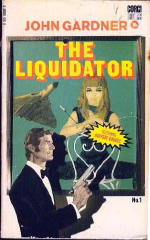May 2008
Monthly Archive
Fri 2 May 2008
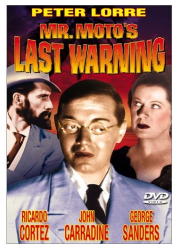
MR. MOTO’S LAST WARNING. 20th Century-Fox, 1939. Peter Lorre, Ricardo Cortez, Virginia Field, John Carradine, George Sanders. Based on the character created by John P. Marquand. Screenwriters; Philip MacDonald and Norman Foster. Director: Norman Foster.
I’m told that Mr. Moto’s Last Warning, the sixth of eight Mr. Moto films – see below – is the only one that’s in the public domain. This explains two things. First, why I was able to buy a copy on DVD at this evening’s local library sale for only $2.00, and secondly why I paid too much, as I discovered later: You can watch the entire movie for free online. Click here.
Disclaimer: I have not watched the free version all the way through, but it appears that it’s the entire film that’s available.
Here’s a complete list of the Mr. Moto films:
* Think Fast, Mr. Moto (1937)
* Thank You, Mr. Moto (1937)
* Mr. Moto’s Gamble (1937)
* Mr. Moto Takes a Chance (1938)
* Mysterious Mr. Moto (1938)
* Mr. Moto’s Last Warning (1939)
* Danger Island (1939)
* Mr. Moto Takes a Vacation (1939)
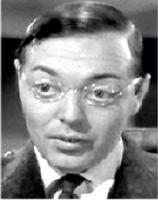
As you see Peter Lorre and 20th Century-Fox stopped making them well before the US became involved in World War II, a wisely-taken cautionary move, as by nationality, Mr. Moto was very definitely Japanese. By profession, he was a secret agent for the “International Police,” and since he was very proficient in either judo or ju jistsu (I imagine there’s a difference) his movies were a lot more action-oriented than either Mr. Chan’s or Mr. Wong’s.
Exemplified quite well, thank you, by Mr. Moto’s Last Warning, in which any number of people are killed or very nearly so, including (surprisingly enough) some of the good guys, one in rather gruesome fashion. Because of a partially muffled sound track at the beginning, it took me a while to figure out what the story was about, but eventually all became clear, except for one question: what country were the bad guys (Cortez and Sanders, primarily) working for? Forthrightly, it is never stated.
Scene: Port Said, Egypt. Plot: To create an incident involving the incoming French fleet that will break the bonds of friendship between France and England. Mr. Moto, working undercover as an antiques dealer, gets wind of the plans and sends out the warning that’s stated in the title.
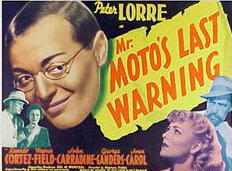
The movie is surprisingly well done. The actors are all pros at this sort of game, the script makes sense (not surprisingly, considering the hand of Philip MacDonald at the helm), and the comedic interludes are only a trifle overdone.
For the most part, the story takes itself seriously. I especially liked the bad girl to good girl transformation of Virginia Field as Connie, lover of Fabian (Ricardo Cortez), the ventriloquist (yes) behind the entire scheme.
That’s her in the lower right corner of the lobby card, the best I’ve been able to come up with. I’m also not sure how well the Peter Lorre image will come out. It looks not quite in focus to me, but it’s the best I can offer so far. Coming directly from the film, I think it should give you a better idea of how he appears in the movie, as compared to the DVD box or even the lobby card.
Fri 2 May 2008
JOHN GARDNER – Understrike.
Corgi; UK paperback reprint, 1966. Hardcover editions: Muller, UK, 1965; Viking, US, 1965. US paperback reprint: Fawcett Crest d1126, 1968
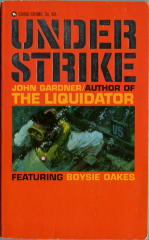
I didn’t purchase too many paperbacks at last weekend’s Windy City show, and only four pulp magazines. Most of the paperbacks I bought came from one dealer very early on, the lot consisting of British espionage thrillers from the 1960s and 70s and written by authors such as James Leasor, James Mayo, Colin Forbes, Alan Williams and so on, all of them pretty much hard to find in this country.
The author most highly represented in this assortment was perhaps also the one most known in the US, John Gardner, his reputation here most likely based on the James Bond books he wrote in 1980s and early 90s. For a complete checklist of his novels and story collections, see Jim Doherty’s obituary for him here when he died in August 2007.
Gardner’s earlier series character was a fellow by the name of Boysie Oakes, a most reluctant spy extraordinaire, and I’ll get back to him in a moment. First, however, here’s a chronological list of the novel length fiction that he appeared in:
BOYSIE OAKES – The Novels.
o The Liquidator. Muller, 1964; Viking, 1964. US pb: Fawcett Crest d856, 1965.
o Understrike. Muller, 1965; Viking, 1965. US pb: Crest, 1968.
o Amber Nine. Muller. 1966; Viking, 1966. US pb: Crest R1173, 1968.
o Madrigal. Muller, 1967; Viking, 1968. US pb: Berkley, 1969.
o Founder Member. Muller, 1969. No US edition.
o Traitor’s Exit. Muller, 1970. No US edition.
o The Airline Pirates. Hodder, 1970; U.S. title: Air Apparent, Putnam, 1971. US pb: Berkley, 1973.
o A Killer for a Song. Hodder, 1975. No US edition.
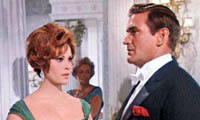
The first of these was made into a film starring Rod Taylor as Boysie, and Jill St. John as his leading lady. The comments on IMDB are fairly positive, and in fact Variety says “Peter Yeldham’s screenplay and Jack Cardiff’s direction combine plenty of action and some crisp wisecracking,” but it doesn’t appear to be available on DVD. I’ll have to see if I can’t track down a copy, maybe on VHS.
The gimmick in the Boysie Oakes books, as I alluded to earlier, is that as a spy, he’s supposedly inept, a coward who’s wracked with fear and stomach cramps at the thought of confronting the enemy, and a consummate womanizer. Or in other words, the direct opposite of Bond, save maybe the last category, although Bond usually stuck to one girl per book (didn’t he?). In Understrike, Oakes strikes up dalliances with two, neither being Elizabeth, his girl friend back home.
It must be a British thing, the sense of humor that enjoys spoofs like this, as there never was a second movie, and many of the books never had US editions. I read The Liquidator, the first in the series, long ago, so I’m relying only on the book at hand, Understrike, and no, the book didn’t quite jell with me, either.
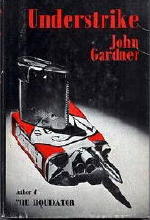
Oakes is a pitiful creature on one page, then (sometimes accidentally) fully capable and in charge on the next. Not having read the first one in so long, it was also never clear to me how he became a secret agent in the first place. It doesn’t seem as though it would to be a position that he’d actively seek out. There’s a story there, obviously, but without it being told in this second tale, there’s something actively missing.
Plot line: The Russian spy apparatus has created an exact double of Boysie, down to the fear and cowardice, as it turns out, with a switch planned to be made shortly before a demonstration of a new US submarine missile off the coast of San Diego, a show of rocket power that Boysie is traveling (under some duress) across country to attend and bear witness to.
Much hilarity is intended to follow, which sounds more sarcastic than I mean to be, but it’s a dry hilarity, British-style, and I do not mean Benny Hill, even though one hugely fortuitous bedroom switch has a large role in the proceeding. Let’s put it this way. I smiled a lot, but I did not burst out loud in guffaws.
Thu 1 May 2008
One of the people I wanted to see at the Windy City pulp and paperback show this past weekend was Martin Grams, Jr., who with Mike Nevins, is the co-author of The Sound of Detection: Ellery Queen’s Adventures in Radio, which is in turn a revision of an earlier book from 1981 by Nevins and Ray Stanich.
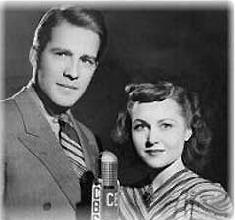
Martin’s just over 30 years old, but as a radio historian, he’s probably the best there’s ever been, already having 15 books on Old Time Radio (and TV) to his credit, including ones on Sam Spade, Inner Sanctum, Suspense, Gang Busters, and (upcoming) The Green Hornet.
Besides the fact that he always has several tables filled with DVDs of old TV show at these affairs, to the dismay of my credit card balance, a major reason I wanted to see him was to ask him about this photo I used in Mike Nevins’ most recent column. It’s a photo of two of the stars of the Ellery Queen radio program. Mike didn’t know I was going to use it – I found it on the Internet somewhere – and neither he nor I could identify who either of them were.
The CBS logo on the microphone helped narrow it down, but not enough to be sure. Martin would know, Mike said, and so he did, at least in part. Right there on the floor of the dealers’ room, Martin whipped out his laptop, fired up his Internet access, took a look at the image on my blog, and said, “That’s Hugh Marlowe, but I’m not sure who the woman is.” She’s the one who (presumably) played Nikki Porter, Ellery’s assistant on the radio shows. (She also appeared in some of the EQ novels and short stories, but not on the regular basis that she was in the radio shows.)
“I think that it’s Marian Shockley, but I’m not positive,” said Martin, and he sent off some emails to some friends of his who might want to chip in on the question. In reply Jim Widner confirmed Hugh Marlowe, but again, he wasn’t positive about Marian Shockley. Which is where the question lies, at the moment, almost but not quite solved.
But as long as we’re talking Ellery Queen here, I’ve found a copy of the Ellery Queen book that Mike was talking about in his column that brought about this question in the first place.
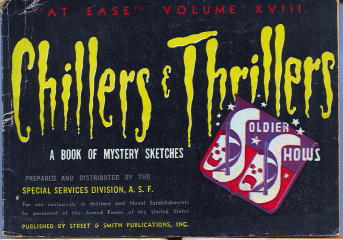
It’s Chillers and Thrillers: A Book of Mystery Sketches. No editor is stated, but as you see, it was published in oblong softcover format by Street & Smith Publications. Prepared and distributed by the Special Services Division, A.S.F. [Army Service Forces], this is Volume XVIII in a series of “At Ease” paperbacks.
The date as stated on the title page: 1945; it is a short 128 pages long.
You can go back and re-read Mike’s column for his discussion of the contents, but since they don’t seem to be documented elsewhere, here’s a complete index. All of the plays are copyright 1945.
* 5 * Part One: “Quick As a Flash” series * introduction & instructions
* 7 * The Mysterious Mr. Harris * Eugene Wang & Harry Kleiner * radio play [Big Town D.A. Steve Wilson]
* 13 * The Rise and Fall of Rome * Eugene Wang & Harry Kleiner * radio play [Pamela North]
* 21 * The Man No One Believed * * Eugene Wang & Harry Kleiner * radio play [Charlie Chan]
* 29 * Murder in the Afternoon * Eugene Wang & Harry Kleiner * radio play [Dr. Ordway, the “Crime Doctor.”]
* 36 * Murder on the Houseboat * Eugene Wang & Harry Kleiner * radio play [Mr. and Mrs. North]
* 41 * The Mystery of the Horse Pistol * Eugene Wang & Harry Kleiner * radio play [Dr. Ordway, the “Crime Doctor.”]
* 47 * Part Two: “Solve a Mystery” series * introduction & instructions
* 51 * The Adventure of the Blue Chip * Ellery Queen * radio play [Ellery Queen]
* 72 * The Adventure of the Foul Tip * Ellery Queen * radio play [Ellery Queen]
* 90 * The Adventure of the Glass Ball * Ellery Queen * radio play [Ellery Queen]
* 108 * The Orderly Room Murder * Anonymous * radio play
* 121 * The Shadow That Walked * Eugene Wang & Harry Kleiner * radio play [Lamont Cranston / The Shadow]
Notes: (1) Quick As a Flash was a radio quiz program on Mutual running on Sundays and later Saturdays from July 16, 1944 to December 17, 1949. As a portion of contest between various contestants, “a fully dramatized short mystery play provided the clues. These plays featured stars of popular detective series, performing as their well known characters.” (The link leads to a webpage listing all of the radio quiz programs hosted by Bill Cullen. Quick As a Flash was one of them.)
(2) On the Big Town radio program, Steve Wilson was not the D.A., but rather the crime-fighting editor of The Illustrated Press.
(3) Jerry North does not appear in the first of the two Mr. & Mrs. North plays.
[UPDATE.] 05-02-08. I received an email from Mark Murphy last night that seems to settle the Marian Shockley question:
This Web page from eBay has what is apparently a picture of Ms. Shockley from Abie’s Irish Rose. See what you think.
Some additional digging reveals that she was married to To Tell the Truth host Bud Collyer.
Hope this helps.
Mark Murphy
>>> And indeed it does. Thanks, Mark. Martin and I are in agreement that the women in the two photos are one and the same. The image is copyright protected, so I won’t show it here. And since it’s an eBay auction, it won’t appear on the Web forever. But it’s there now; take a look while you can.
« Previous Page




